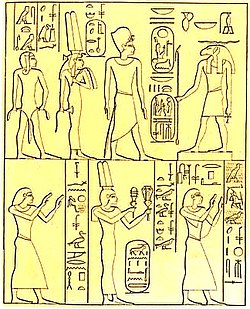Chaemwaset (son of Ramses II)
| Chaemwaset (son of Ramses II) in hieroglyphics | |||||||||||
|---|---|---|---|---|---|---|---|---|---|---|---|
| New kingdom |
also
Chaemwaset (Cha em Waset) Ḫˁj m W3st Who appeared in Thebes |
||||||||||
| Priestly title Horus Iunmutef |
Hor-Iun-mutef-sem Ḥr.w-Jwn-mw.t = f-sm Horus Iunmutef, Sem-priest |
||||||||||
| Priest title Medu-jau |
Medu-jau Mdw-j3w staff (of the father) |
||||||||||
Chaemwaset (also Cha-em-Waset ; Chaemwese ; * around 1281 BC; † 1225 BC) already held a priestly position in the Apis cult at a young age , which he held after the construction of the serapeum in Practiced Saqqara . Further construction activities and restoration of old Memphite graves formed the basis for the designation “first of the archaeologists ”.

background
Origin and first priestly activities
Chaemwaset was born as the fourth son of Ramses II , second son of the second Great Royal Wife Isisnofret , probably before his father took over the government. In higher priesthoods, Chaemwaset is attested from the 21st year of Ramses II's reign (1259 BC).
Chaemwaset himself describes these years of his priesthood: "The office of Junmutef was made great by Ptah ". A few years later he took over the post of " High Priest of Ptah " in Memphis, which is occupied from the 32nd year of Ramses II's reign (1248 BC). After another two years he practiced in 1246 BC. Activities of the priestly title "Horus-Junmutef", but at this time without explicit mention as a priest "Horus-Junmutef". Chaemwaset had in 1246 BC Reached an age of about mid-thirties.
Chaemwaset's rise
Chaemwaset was in charge of proclaiming some of his father's sed festivals . But he is best known for his work in the Memphite necropolis . On various pyramids of the Old and Middle Kingdom he had inscriptions that name him and his father placed. In addition, he is assigned archaeological activities in Saqqara , which earned him the reputation of the "first archaeologist". The more recent research, however, sees this in a somewhat more differentiated manner. Most of these pyramids were torn down as quarries by his father for his building projects. The inscriptions seem to have had the purpose of maintaining a minimal cult while the actual pyramid temples were removed.
In doing so he may have gathered a certain knowledge of the ancient scriptures and times. His work in the Memphite necropolises in the area around Memphis and his medical expertise probably led to the fact that the people saw him as gifted with Heka powers, i.e. considered him a kind of " magician ". His memory was later preserved in demotic literature in the "Setne Stories". Further evidence of his work has been preserved to this day in the temple of the Haremhab in Jabal al-Silsila and in the Ptah temple in Memphis.
Chaemwaset died at the age of 56 in the 55th year of his father's reign; some time earlier he had been made crown prince. His grave was probably in Saqqara , where individual components were found.
literature
- Marjorie Fisher: The sons of Ramesses II (= Egypt and Old Testament. Vol. 53). 2 volumes. Harrassowitz, Wiesbaden 2001, ISBN 3-447-04486-1 (also: Michigan, Univ., Diss., 1999).
- Farouk Gomaà: Chaemwese. Son of Ramses II and high priest of Memphis (= Egyptological treatises. Vol. 27). Harrassowitz, Wiesbaden 1973, ISBN 3-447-01543-8 (also: Wiesbaden, Univ., Diss., 1973).
- Boyo Ockinga: The image of God in ancient Egypt and in the Old Testament (= Egypt and Old Testament. Vol. 7). Harrassowitz, Wiesbaden 1984, ISBN 3-447-02513-1 (also: Tübingen, Univ., Diss., 1983).
Web links
Individual evidence
- ↑ Hieroglyphs for Chaemwaset in the temple of Amenhotep III. from el-Kab to: CR Lepsius : Monuments from Egypt and Ethiopia. Edited by Eduard Naville . Volume 4: Upper Egypt. Hinrichs, Leipzig 1901, p. 41, penultimate line, ( online ).
- ↑ a b c d Marjorie M. Fisher: The sons of Ramesses II. 2001, pp. 103-104.
- ↑ Jaromír Málek : A Meeting of the Old and New. Saqqara during the New Kingdom. In: Alan B. Lloyd (Ed.): Studies in Pharaonic Religion and Society. In Honor of J. Gwyn Griffiths (= The Egypt Exploration Society. Occasional Publications. Vol. 8). Egypt Exploration Society, London 1992, ISBN 0-85698-120-6 , pp. 57-76.
- ^ Aidan Dodson , Dyan Hilton: The Complete Royal Families of Ancient Egypt. Thames & Hudson, London 2004, ISBN 0-500-05128-3 , p. 170.
| personal data | |
|---|---|
| SURNAME | Chaemwaset |
| ALTERNATIVE NAMES | Chamuaset |
| BRIEF DESCRIPTION | Son of Ramses II and high priest of Memphis |
| DATE OF BIRTH | around 1281 BC Chr. |
| DATE OF DEATH | 1225 BC Chr. |
